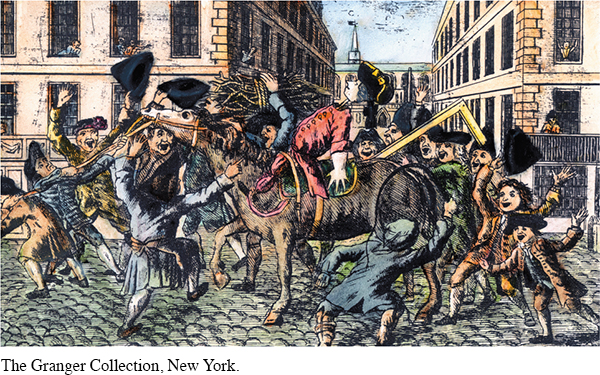The American Promise: Printed Page 147
The American Promise, Value Edition: Printed Page 135
The American Promise: A Concise History: Printed Page 155
Resistance Strategies and Crowd Politics
News of the Stamp Act arrived in the colonies in April 1765, seven months before it was to take effect. There was time, therefore, to object. Governors were unlikely to challenge the law, for most of them owed their offices to the king. Instead, the colonial assemblies took the lead; eight of them held discussions on the Stamp Act.
Virginia’s assembly, the House of Burgesses, was the first. At the end of its May session, after two-
Two more fiery resolutions were debated as Henry pressed the logic of his case to the extreme. The sixth resolution denied legitimacy to any tax law originating outside Virginia, and the seventh boldly called anyone who disagreed with these propositions an enemy of Virginia. This was too much for the other representatives. They voted down resolutions six and seven and later rescinded their vote on number five as well.
Their caution hardly mattered, however, because newspapers in other colonies printed all seven Virginia Resolves, creating the impression that a daring first challenge to the Stamp Act had occurred. Consequently, other assemblies were willing to consider even more radical questions, such as this: By what authority could Parliament legislate for the colonies without also taxing them? No one disagreed, in 1765, that Parliament had legislative power over the colonists, who were, after all, British subjects. Several assemblies advanced the argument that there was a distinction between external taxes, imposed to regulate trade, and internal taxes, such as a stamp tax or a property tax, which could only be self-

The American Promise: Printed Page 147
The American Promise, Value Edition: Printed Page 135
The American Promise: A Concise History: Printed Page 155
Page 148Reaction to the Stamp Act ran far deeper than political debate in assemblies. Every person whose livelihood required official paper had to decide whether to comply with the act. The first organized resistance to the Stamp Act began in Boston in August 1765 under the direction of town leaders, chief among them Samuel Adams, John Hancock, and Ebenezer Mackintosh. Adams and Hancock, both Harvard graduates, were town officers. Adams, in his forties, had shrewd political instincts and a gift for organizing. Hancock, not yet thirty, had inherited an uncle’s shipping business and was one of the wealthiest men in Massachusetts. Mackintosh, also a young man, was a shoemaker and highly experienced street activist. (See “Experiencing the American Promise: Pursuing Liberty, Protesting Tyranny.”) Many other artisans, tradesmen, printers, tavern keepers, dockworkers, and sailors—
The American Promise: Printed Page 147
The American Promise, Value Edition: Printed Page 135
The American Promise: A Concise History: Printed Page 155
Page 149The plan hatched in Boston called for a large street demonstration highlighting a mock execution designed to convince Andrew Oliver, the designated stamp distributor, to resign. On August 14, 1765, a crowd of two thousand to three thousand demonstrators, led by Mackintosh, hung an effigy of Oliver in a tree and then paraded it around town before finally beheading and burning it. In hopes of calming tensions, the royal governor Francis Bernard took no action. The next day Oliver resigned his office in a well-
The demonstration provided lessons for everyone. Oliver learned that stamp distributors would be very unpopular people. Governor Bernard, with no police force to call on, learned the limitations of his power to govern. The demonstration’s leaders learned that street action was effective. And hundreds of ordinary men not only learned what the Stamp Act was all about but also gained pride in their ability to have a decisive impact on politics.
The American Promise: Printed Page 147
The American Promise, Value Edition: Printed Page 135
The American Promise: A Concise History: Printed Page 155
Page 150Twelve days later, a second crowd action showed how well these lessons had been learned. On August 26, a crowd visited the houses of three detested customs and court officials, breaking windows and raiding wine cellars. A fourth target was the finest dwelling in Massachusetts, owned by Thomas Hutchinson, lieutenant governor of Massachusetts and the chief justice of the colony’s highest court. Rumors abounded that Hutchinson had urged Grenville to adopt the Stamp Act. Although he had actually done the opposite, Hutchinson refused to set the record straight, saying curtly, “I am not obliged to give an answer to all the questions that may be put me by every lawless person.” The crowd attacked his house, and by daybreak only the exterior walls were standing. Governor Bernard gave orders to call out the militia, but he was told that many militiamen were among the crowd.
The destruction of Hutchinson’s house brought a temporary halt to protest activities in Boston. The town meeting issued a statement of sympathy for Hutchinson, but a large reward for the arrest and conviction of rioters failed to produce a single lead. Hutchinson believed that Adams commanded Mackintosh, but Adams denied involvement and professed shock at the “truly mobbish Nature” of the violence. Essentially, the opponents of the Stamp Act in Boston had triumphed; no one replaced Oliver as distributor. When the act took effect on November 1, ships without stamped permits continued to clear the harbor. Since he could not bring the lawbreakers to court, Hutchinson, ever principled, felt obliged to resign his office as chief justice. He remained lieutenant governor, however, and within five years he became the royal governor.